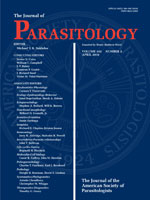Gyrodactylus salmonis is a common ectoparasite on the fins and body of North American salmonids in fresh water. In this study, the spatial distribution of G. salmonis on 60 captive hatchery-reared rainbow trout, Oncorhynchus mykiss, is reported. The highest parasite densities occurred on 5 × 5–mm2 sections of the dorsal fin followed by the trunk, other fins, and the olfactory chamber, with the lowest densities on the head. The finding of infections within the olfactory chamber of 93% of the fish was unexpected. One possibility is that such infections represented spillover from high-density infrapopulations that occur on the skin and fins. However, this possibility is unlikely, because worm densities at various sites along the body surface of infected fish did not correlate with densities within the olfactory chamber. The parasite conceivably enters the chamber either via water incurrent or by crawling in from the head and subsequently remaining at this site to feed and reproduce. Results from scanning electron microscopy are consistent with physical modification to the olfactory epithelium associated with the attachment/reattachment of the opisthaptor and epithelial grazing.
How to translate text using browser tools
1 April 2016
Spatial Distribution of Gyrodactylus salmonis (Monogenea) on the Body of Captive Fingerling Oncorhynchus mykiss, Including Attachment Within the Olfactory Chamber
Ebrahim Lari,
David K. Cone,
Cameron P. Goater,
Greg G. Pyle
ACCESS THE FULL ARTICLE

Journal of Parasitology
Vol. 102 • No. 2
April 2016
Vol. 102 • No. 2
April 2016




